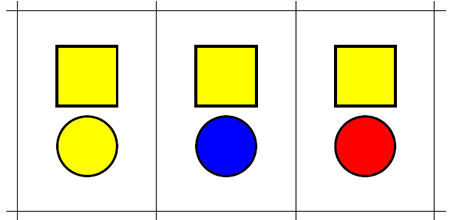Shaping up
Are all the possible combinations of two shapes included in this
set of 27 cards? How do you know?
Problem
For this activity, you'll need to print out these cards. There are 27 different cards in total. Here is a picture of just three of them:
Image

What rules were used to make the 27 cards, do you think?
Have all the possible combinations of two shapes been included?
How do you know?
If the rules were changed so that a card has two triangles, what would the complete set of cards contain?
This problem is based on ideas from "It Makes You Think", a book and CD of mathematical puzzles and problems, produced by Jill Mansergh and available from The Association of Teachers of Mathematics (ATM)
Getting Started
It might help to arrange the cards somehow.
Which shapes don't appear on a card together?
How do you know what all the possible combinations are?
You might want to have a pen and paper handy for jotting things down.
Student Solutions
We haven't received any solutions to this problem yet and so we'd love to hear from you if you have any ideas.
Teachers' Resources
Why do this problem?
Shaping Up encourages children to systematise and therefore ask themselves questions. Working on this problem is a great context for exploring the idea of combinations.Possible approach
Ideally, it would be good if children had a set of the cards to work with in pairs.
You could introduce the activity by asking the children to describe the cards. Many will mention the coloured shapes and the fact that there are two shapes on each card. Encourage them to be more specific in their desciptions by asking them about the "rules" that they think were used to make the cards. They could talk about this in their pairs before sharing ideas with the whole group.
In order to find out whether all the possible combinations are included in the cards, again, allow them some thinking time in pairs first. How are they going to find out? Take a few minutes to discuss their ideas amongst the whole class - this might involve doing some recording, or arranging the cards in a particular way. There is no right way to go about it, but what is important is having
a system or order of some kind so that they know there aren't any missing.
Key questions
Can you arrange the cards in a way that will help you find all the combinations?
Which shapes appear on a card with the yellow square? Are there any that don't appear with the yellow square?
Which shapes appear on a card with the red square ... the blue square ...?
Possible extension
Challenge children to create an equivalent set of cards. You could invite them to use any design they choose, but you could always have a few suggestions up your sleeve, for example three other shapes.
